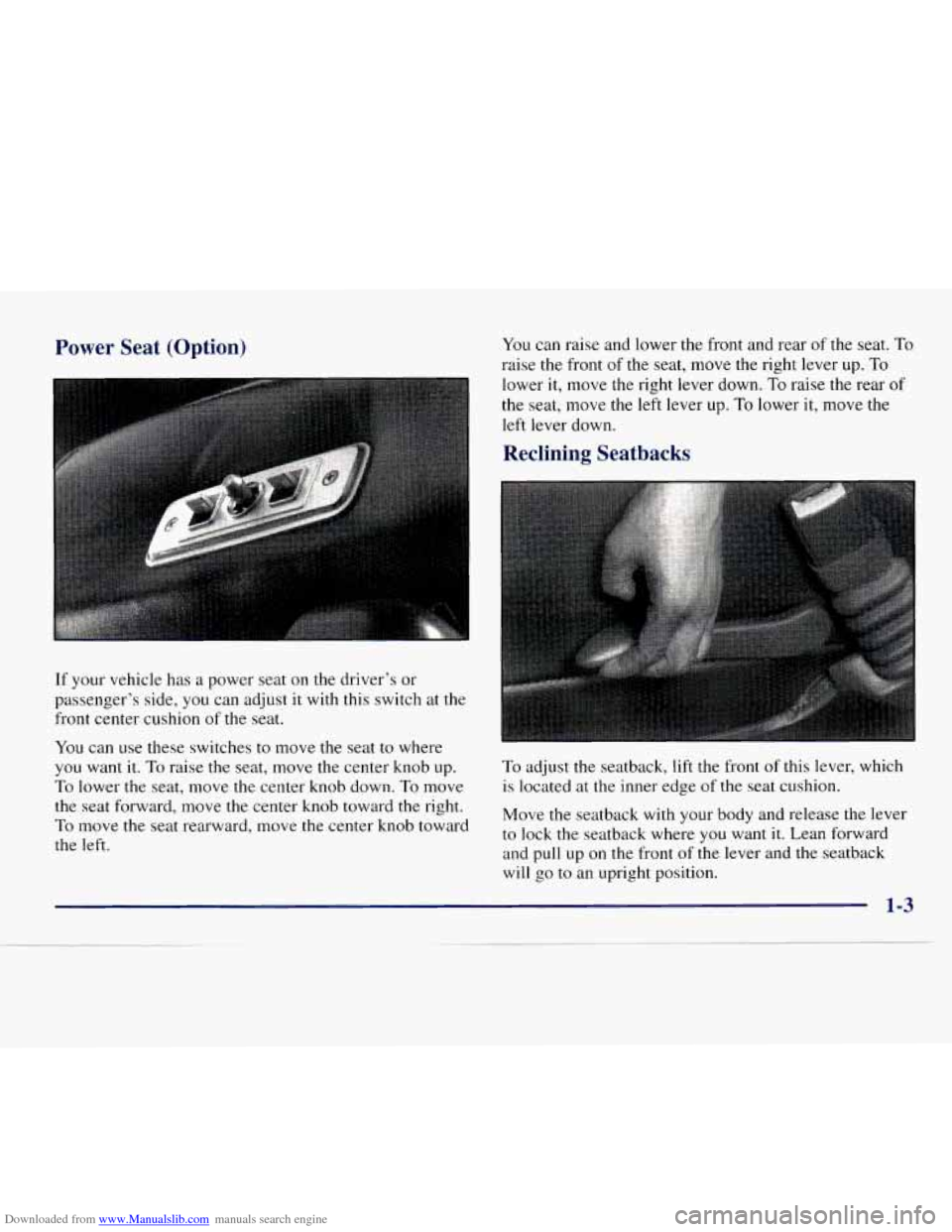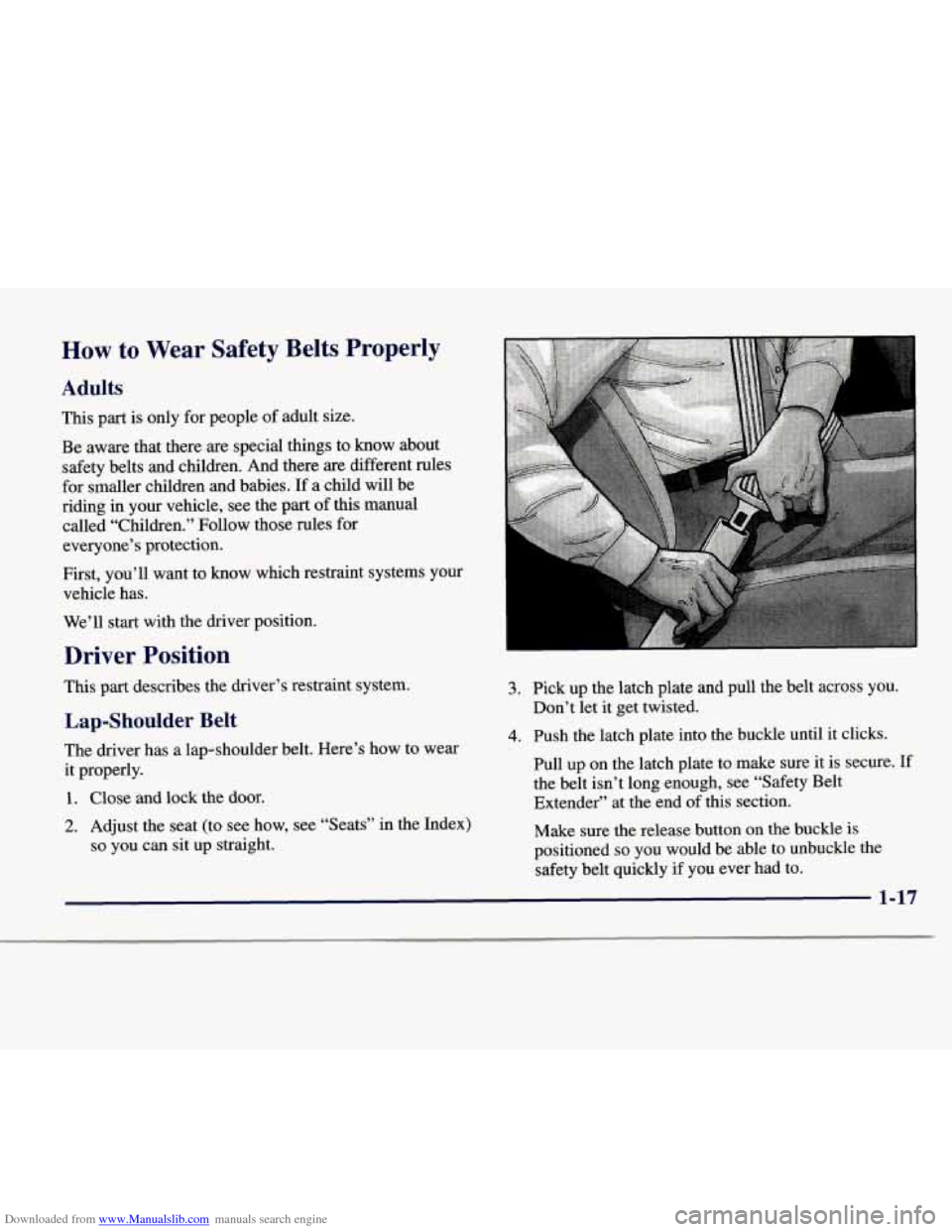Page 6 of 386
Downloaded from www.Manualslib.com manuals search engine Vehicle Symbols
These are some of the symbols you may find on your vehicle.
For example,
these symbols
are used on an
original battery:
POSSIBLE A
CAUTION
INJURY
PROTECT EYES BY
SHIELDING
CAUSTIC
ACID COULD
x
BATTERY
CAUSE
BURNS
AVOID
SPARKS
OR
FLAMES
SPARK
OR ,111,
COULD FLAME
EXPLODE BATTERY
These symbols are important
for you and
your passengers
whenever your
vehicle is
driven
:
DOOR LOCK
UNLOCK
FASTEN SEAT
BELTS
These symbols
have
to do with
your lamps:
SIGNALS e
TURN
WARNING
A
HAZARD
FLASHER
FOG LAMPS
$0
These symbols
are on some
of
your controls:
WINDSHIELD
WIPER
WINDSHIELD DEFROSTER
WINDOW
DEFOGGER
VENTILATING FAN
These symbols are used on
warning and
indicator lights:
COOLANT -
TEMP -
CHARGING BATTERY
SYSTEM
BRAKE
(a)
COOLANT a
ENGINE OIL
PRESSURE
Wh
ANTI-LOCK (@)
BRAKES
Here are some
other symbols
you may see:
FUSE -%-
I
LIGHTER
HORN
b
SPEAKER
b
FUEL p3
V
Page 9 of 386
Downloaded from www.Manualslib.com manuals search engine Seats and Seat Controls
This part tells you about the seats -- how to adjust them,
take them out and put them back in. It also tells you
about reclining front seatbacks.
Manual Front Seats
The bucket seats can be adjusted forward or rearward
with the lever at the front
of the seat.
To adjust the seat, pull the lever up to release the seat
bottom and slide the seat where
you want it. Then
release the lever and try
to move the seat with your
body, to make sure the seat
is locked into place.
You can lose control of the vehicle if you try to
adjust a manual driver’s seat while the vehicle is
moving. The sudden movement could startle and
confuse you, or make you push a pedal when
you
don’t want to. Adjust the driver’s seat only when
the vehicle is not moving.
1 I
1-2
Page 10 of 386

Downloaded from www.Manualslib.com manuals search engine Power Seat (Option)
If your vehicle has a power seat on the driver’s or
passenger’s side,
you can adjust it with this switch at the
front center cushion of the seat.
You can use these switches to move me seat to where
you want it. To raise the seat, move the center knob up.
To lower the seat, move the center knob down. To move
the seat forward, move the center knob toward the right.
To move the seat rearward, move the center knob toward
the left.
You can raise and lower the front and rear of the seat. To
raise the front of the seat, move the right lever up. To
lower it, move the right lever down. To raise the rear of
the seat, move the left lever up. To lower it, move the
left lever down.
Reclining Seatbacks
To adjust the seatback, lift the front of this lever, which
is located at the inner edge of the seat cushion.
Move the seatback with your body and release the lever
to lock
the seatback where you want it. Lean forward
and pull up on the front
of the lever and the seatback
will
go to an upright position.
Page 14 of 386
Downloaded from www.Manualslib.com manuals search engine 3. Locate the red handle on the inboard side of the seat
base and rotate it up.
4. Once the red handle is rotated up, pull the handle to
remove the locking pin.
5. Stow the locking pin on the rear of the seat base in
6. Repeat this procedure for the pin on the other
the
hole that is provided.
seat base.
7. Pull the seat rearward about two inches (5 cm) and
then
lift the seat from the floor rails.
8. Remove the seat from the vehicle.
9. Install the trim covers to the floor rails. These are
supplied in a cardboard box at delivery.
Page 16 of 386

Downloaded from www.Manualslib.com manuals search engine Replacing the Rear Seat
A CAUTION:
A seat that isn’t locked into place properly can
move around in a collision
or sudden stop. People
in the vehicle could be injured. Be sure to lock
the seat into place properly when installing it.
-
1 A CAUTION:
- -
A safety belt that is twisted or not properly
attached won’t provide the protection needed in a
crash. The person wearing the belt could be seriously injured. After installing the seat, always
check to be sure that the safety belts are not
twisted and are properly attached.
1. Remove the trim covers from the floor rails and store
for future use.
2.
3.
4.
Position the seat into the open slots in both rails.
Push the seat forward
in the rail, hooking both seat
bases onto the pins inside
of the rails.
Both locking pins that locked the seat into place
must be installed before operating the vehicle.
To install the locking pin at the rear of the seat base,
pull the carpet/mat flap back on the inboard side
to
locate the hole in the rail for the pin.
5. Remove the pin from its stowed position on the seat
base while
holding the carpedmat flap back.
Page 17 of 386
Downloaded from www.Manualslib.com manuals search engine 6. Insert the red handled locking pin into the seat
base, lifting the seat slightly to line up the pin with
the base. 7.
8.
9.
10. Rotate
the red handle down until it
is in the
retaining clip.
Replace the carpet/mat flap to its original position.
Repeat this procedure
for the other seat base.
Connect the quick release latch plates for the lap
shoulder belts by inserting the latch plates into the
buckles attached at the outboard positions of the
bench seat. Do not twist the belt.
Page 24 of 386

Downloaded from www.Manualslib.com manuals search engine How to Wear Safety Belts Properly
Adults
This part is only for people of adult size.
Be aware that there
are special things to know about
safety belts
and children. And there are different rules
for smaller children and babies. If a child will be
riding in your vehicle, see the part of this manual
called “Children.” Follow those rules for
everyone’s protection.
First, you’ll want to know which restraint systems your
vehicle has.
We’ll start with the driver position.
Driver Position
This part describes the driver’s restraint system.
Lap-Shoulder Belt
The driver has a lap-shoulder belt. Here’s how to wear
it properly.
1. Close and lock the door.
2. Adjust the seat (to see how, see “Seats” in the Index)
so you can sit up straight.
3. Pick up the latch plate and pull the belt across you.
Don’t let it get twisted.
4. Push the latch plate into the buckle until it clicks.
Pull up on the latch plate to make sure it is secure.
If
the belt isn’t long enough, see “Safety Belt
Extender” at the end of this section.
Make sure the release button on the buckle is
positioned
so you would be able to unbuckle the
safety belt quickly if you ever had to.
1-17
Page 25 of 386
Downloaded from www.Manualslib.com manuals search engine 5. To make the lap part tight, pull down on the buckle
end of the belt as you pull up on the shoulder belt. The lap part
of the belt should be worn low and snug on
the hips, just touching the thighs. In a crash, this applies
force to the
strong pelvic bones. And you'd be less likely
to slide under the lap belt.
If you slid under it, the belt
would apply force at your abdomen. This could cause serious or
even fatal injuries. The shoulder belt should go
over the shoulder and across the chest. These parts of the
body are best able to take belt restraining forces.
The safety belt locks if there's
a sudden stop or a crash.
1-18